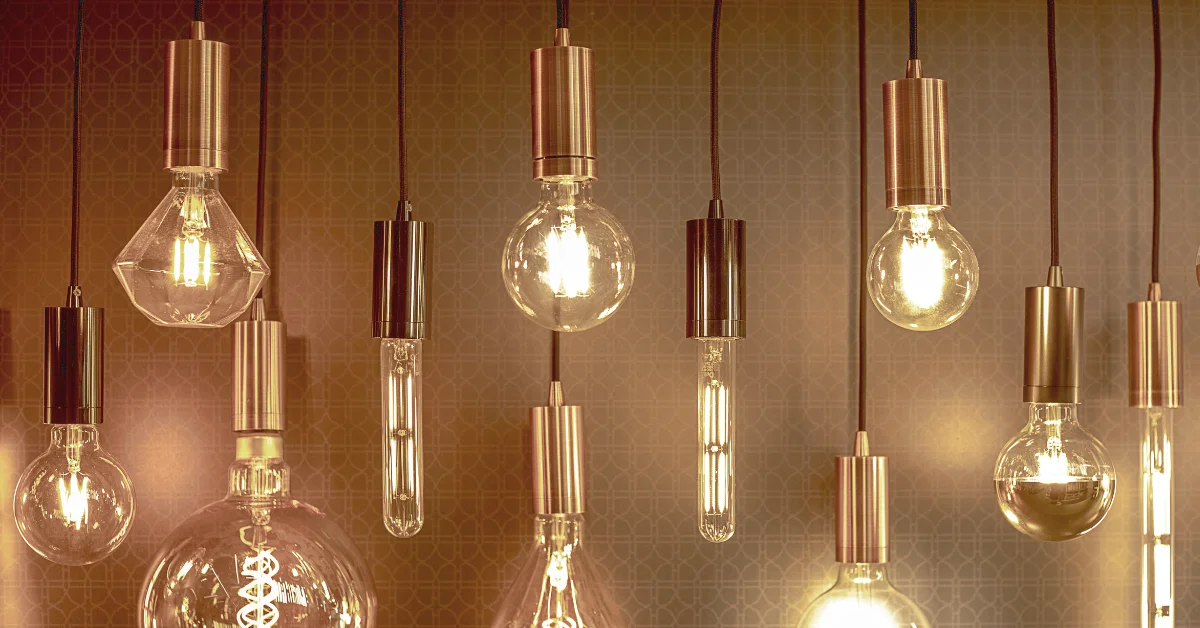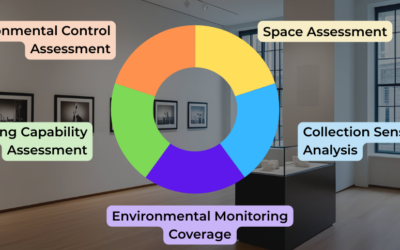Museum lights are essential for displaying and appreciating collections, but they can also pose a risk to the preservation of objects with damage that is both cumulative and irreversible. In the past, object preservation was considered the most important aspect of collections stewardship and environmental control took precedence over the potential damage associated with collection use and display. If this is a topic of particular interest to you, make sure you read this Report on Collections Use and Access by the Smithsonian Organization and Audience Research and this article on touching heritage objects by Jane Henderson and Ashley Lingle.
Today, however, we recognize that collections are there to serve communities, so it is essential for collections care professionals to balance the needs between accessibility and conservation. This is especially true when thinking about museum lights, lighting levels, and visitor experience.
This short article aims to be a guide that will provide some tips and best practices for choosing and using museum lights in a way that enhances both the longevity of collections and their appreciation by your audience.
What are the effects of museum lights on collections?
Museum lights can cause damage to collections in various ways, depending on the type, intensity, duration, and spectrum of the light source. Some of the common effects of museum lights, or indeed, any lights include:
- Fading or discoloration of pigments, dyes, inks, and other organic materials.
- Cracking or flaking of paint layers, varnishes, glazes, and coatings.
- Embrittlement or weakening of paper, textiles, leather, and other fibrous materials.
- Oxidation or corrosion of metals, glass, ceramics, and other inorganic materials.
- Unintentional lowering effects on the relative humidity around an object caused by the heat emitted by the lights.
How to choose museum lights for collections?
Not all museum lights are created equal. Or rather, not all commercial lights are appropriate for museum use. Some lights are more suitable for collections than others, depending on their characteristics and performance. If you are currently on the market for museum lights, don’t miss our other articles for guidance:
- Best Museum Light Bulbs To Support Preventive Conservation
- Balancing Light Levels in Museums & Preventive Conservation Goals
- How LED Lighting For Museums Helps Conservation & Sustainability
- Museum Lighting Guidelines – 7 Open Access Articles To Help Your Collection
- Measuring Museum Art Lighting With Data Loggers & Sensors
In general, think about the following aspects:
- Light spectrum: Avoid bulbs that emit ultraviolet (UV) and infrared (IR) radiation. Both are invisible but can cause damage by accelerating fading and causing drying out through heating. Generally speaking, audiences seem to prefer lights that mimic natural light.
- Light intensity: This refers to the amount of light that a light source produces or an object receives. While it used to be expressed in either foot-candles or lux depending on whether you were on an Imperial or metric system, it is more common for collections staff to use lux these days. Museum lights should have a low and adjustable light intensity that provides sufficient illumination for viewing without causing excessive damage to collections. The recommended light intensity levels vary depending on the sensitivity of the materials and the display duration of the objects. When talking about lighting versus accessibility, lighting intensity is the most important aspect. Some audiences may find that your exhibits are simply too dark for them to appreciate, and this must be taken into account when designing exhibition schedules.
- Light duration: The light duration refers to the length of time that a light source is on or an object is exposed to light and it is normally expressed in lux hours. While we could tell you that museum lights should have a limited and controlled light duration that reduces the cumulative damage to collections, remember that exposure is a factor of light intensity and duration taken together, so that it is possible to light an object at a higher intensity for a shorter period of time and still come out with the same exposure time. The recommended light duration levels vary depending on the sensitivity of the materials and the display frequency of the objects. For example, according to Museums Galleries Scotland, annual light exposure is calculated at seven hours per day for six days a week for 52 weeks and gives an average of 2,184 hours per object per year. This number is then multiplied by the light intensity to give a maximum 100,000 lux hours for sensitive items and 450,000 lux hours for moderately sensitive objects. How you decide to distribute these lux hours will be up to you, your audience profile, and your collection goals. Remember that turning off lights when museums close doors to visitors will help not only to add hours to the lux hour budget but also to reduce your exhibition carbon footprint.
- Light distribution: The light distribution refers to the angle and direction that a light source emits or an object receives light. Museum lights should have a uniform and focused light distribution that avoids creating shadows, glare, or hotspots on collections. The optimal light distribution depends on the shape, size, texture, and reflectance of the objects. And remember that glare will also show up in different spots depending on the height of your visitors! If you can have the advice of a light designer during this task, it will help you to distribute the light considering other factors such as the number of lamps or lights you have, and curatorial and exhibition considerations.
- Light quality: The light quality refers to the color rendering and fidelity that a light source provides or an object displays. Museum lights should have a high and consistent light quality that reproduces the true colors and tones of collections without distorting or altering them. The common measure of light quality is the color rendering index (CRI), which ranges from 0 to 100. Museum lights should have a CRI of at least 80 for general display and at least 90 for critical color matching.
- Light flicker: The light flicker refers to the rapid and repeated change in brightness or color that a light source produces or an object perceives. Museum lights should have a low and imperceptible light flicker that does not cause visual discomfort, fatigue, or distraction for visitors or staff. In worst-case scenarios, flicker on sensitive individuals can cause photosensitive seizures or even aggravation of autistic behaviors. The common measure of light flicker is the flicker percentage, which ranges from 0% to 100%. It is also measured in a 0-1.0 flicker index. At 120Hz frequency lights, flicker should be no more than 10% or possibly lower for sensitive audiences. Read more about flicker.
- Light heat: The light heat refers to the amount of thermal energy that a light source emits or an object absorbs. Museum lights should have a low and manageable light heat that does not cause excessive temperature or humidity fluctuations in the display environment or on the surface of collections. Museum lights should have a low wattage that is proportional to the light output and efficiency. If you are unsure, go for high quality modern LEDs which should have little to no infrared radiation (IR). Heat is not directly relevant to your visitor’s experience, but is key to preserving objects, don’t overlook it!
What are the types of museum lights for collections?
There are many types of museum lights available on the market, each with its own advantages and disadvantages for collections. For an article that is all about types of museum lights, head over to our other article, Best Museum Light Bulbs To Support Preventive Conservation. We talk in detail about types of bulbs and recommendations for heritage institutions.
How to balance museum lights and visitor experience?
Choosing the right type of museum lights for collections is only the first step. Collections care specialists also need to use museum lights in a way that optimizes the visitor experience and minimizes the conservation risks. Here are some tips you can use:
- Monitor and measure: Monitor and measure the light levels and conditions in the display areas using appropriate tools and methods. Use lux meters to measure the light intensity, spectrometers to measure the light spectrum, data loggers to measure the light duration, and thermohygrometers to measure the temperature and humidity. This monitoring will allow you to better calculate the exposure time for your different objects and make decisions that favor accessibility. You can play with your light intensity and have special hour visits for elderly visitors or groups with challenges related to visual acuity or any other disabilities that require changes in lighting. Think about lighting angle to avoid glare for visitors with different viewing heights.
- Adjust and control: Change the light levels and conditions in the display areas using appropriate devices and systems. For example, leverage filters to block UV and IR radiation, dimmers to reduce light intensity, timers to limit light duration, sensors to detect motion or daylight, and blinds or curtains to block external sources. Give your visitors the option to uncover items that are more sensitive than others so that they can lie in the dark until a person wishes to look at them. These occasional exposures to light will reduce the total amount of exposure. If you put a real-time data logger next to the item behind the curtain or in the drawer, you will be able to get actual numbers for total exposure and perhaps extend the exhibition period.
- Rotate and rest: Make sure you have a collections policy that clearly dictates any rotation and rest periods for items sensitive to light. You can then use exposure limits to determine how long an object can be displayed before it needs to be rested in dark storage, or apply rotation plans to alternate between different objects or groups of objects in the same display space. If you do not have the staff to be constantly rotating objects and having to change mounts and display cases for this purpose, then you will know that your lux exposure will have to be more limited. In these cases, try to find other ways to cater to your different audiences or prioritize the display of objects that are more light resistant. When sensitive objects are considered to be exhibited for longer periods don’t forget to bring up this conversation with different stakeholders and take a risk assessment approach to make a better decision.
- Educate and communicate: Don’t forget your visitors (and staff) are interested parties. They are here because they want to see and learn more! Don’t miss your chance to educate and communicate with visitors and staff about the effects of museum lights on collections and the measures you have taken to prevent, manage, or reduce them. Use labels, signs, flyers, or online platforms to explain why some objects are dimly lit or not displayed at all times, or offer training sessions or workshops to teach about light damage and exhibition techniques.
- Leverage technology: In the 21st century museum, you can now take advantage of various types of smart technologies for light management. Experiment with mobile apps attached to smart lights and crystal films. If you can’t afford to at the moment, reach out to your colleagues and ask them about their experiences using this kind of technology to control light exposure depending on visitor profiles.
Conclusions
Museum lights are both an opportunity and a challenge for collections care specialists. By choosing and using museum lights wisely and, most of all, flexibly, you can create an engaging, inclusive, and enjoyable visitor experience while preserving the integrity of your collections. Again, don’t forget to ask your colleagues what they are doing at their institutions to improve visitor experience without endangering the objects.
If you have any questions about environmental monitoring, integrated pest management, or just want to talk about preventative conservation, please reach out to us! Don’t forget to check out our blog or join our community of collections care professionals where you can discuss hot topics, connect with your peers or even take a course to get familiar with the Conserv platform.




